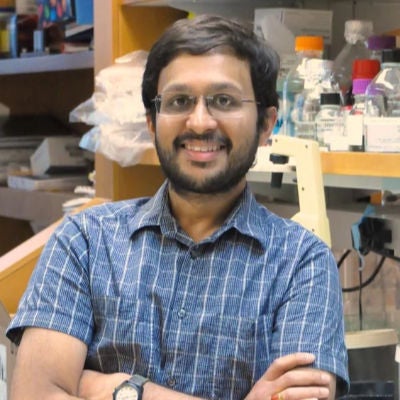- Assistant Professor
- Phone: 401.874.9730
- Email: arnob@uri.edu
- Office Location: CBLS, Rm 287
Research
Role of chromatin modifiers in disease
DNA in eukaryotes is packaged into higher order chromatin structure. Access to the underlying DNA is orchestrated by functions of large multi-subunit chromatin modifying complexes, which either post-translationally modify residues on histone tails or use ATP to slide/evict histones. A common theme of recent large-scale genomic studies is the identification of chromatin modifiers as targets for mutations in cancer and human diseases. Among ATP-dependent chromatin modifiers, the evolutionarily conserved Swi/Snf complex has emerged as a prime target, with subunits of this complex being mutated in 20% of all human cancers. Interestingly, these mutations are not restricted to the catalytic proteins, but most often affect accessory subunits of the complexes, resulting in complete loss of proteins themselves. This makes them non-targetable by drugs in the diseased states. While the focus of many studies has helped uncover the catalytic roles of these complexes in altering chromatin structure, less is understood about how the non-catalytic proteins contribute towards composition, protein-interactions and functions of the chromatin remodeling complex. Furthermore, while mutations of several Swi/Snf subunits have been associated with some cancers; others affect specific tissue types. Interestingly, several members that display tissue specific disease phenotypes have orthologues, which can be used interchangeably to form unique iterations of Swi/Snf. Since tissue specific gene expression allows for unique identity and function of differentiated cells, understanding how individual subunits contribute to activity of the complex and gene regulation in specific tissues that are altered in disease is of critical importance. Using biochemical and genomic approaches, the studies in the laboratory are primarily focused on understanding the molecular mechanisms that regulate transcription when functions of the Swi/Snf chromatin modifying enzyme are compromised by mutations within its subunits.
Education
- Ph.D., Pennsylvania State University, 2010
- M.Sc., Tata Institute of Fundamental Research, Mumbai, India, 2004
- B.Sc., Ramnarain Ruia College, Mumbai University, Mumbai, India, 2001
Selected Publications
Dutta A*, Gogol MM, Sardiu M, Gilmore J, Florens L, Washburn MP and Workman JL*. Composition and Function of Mutant Swi/Snf Complexes. (Cell Reports- in press) * co-corresponding authors
Dutta A and Workman JL. In vitro assembly of nucleosomes for binding/remodeling assays. (2017) Methods Mol Biol. 2017;1528:1-17
Dyer JO*, Dutta A*, Yu X, Dialynas G, Seidel C, Zhang Y, Florens L, Washburn MP, Abmayr SM and Workman JL. Myeloid Leukemia Factor Acts in a Chaperone Complex to Regulate Transcription Factor Stability and Gene Expression. (2016) Journal of Molecular Biology (in press) (* Equal contribution)
Dutta A, Abmayr SM and Workman JL. Diverse activities of histone acylations connect metabolism to chromatin function. (2016) Molecular Cell. 63(4): 547-52
Huang F, Saraf A, Florens L, Kusch T, Swanson SK, Szerszen LT, Li G, Dutta A, Washburn MP, Abmayr SM, Workman JL. The Enok acetyltransferase complex interacts with Elg1 and negatively regulates PCNA unloading to promote the G1/S transition. (2016) Genes and Development. 30(10): 1198-210
Dutta A, Babbarwal V, Fu J, Brunke-Reese D, Libert DM, Willis J, Reese JC. Ccr4-Not and TFIIS function cooperatively to rescue arrested RNA polymerase II. (2015) Mol Cell Biol. 35(11): 1915-25
Huang F, Paulson A, Dutta A, Venkatesh S., Smolle M., Abmayr SM, and Workman JL. Histone Acetyltransferase Enok Regulates Oocyte Polarization by Promoting Expression of the Actin Nucleation Factor spire. (2014) Genes and Development. 28(24): 2750-63
Dutta A, Gogol M, Kim JH, Smolle M, Venkatesh S, Gilmore J, Florens L, Washburn MP and Workman JL. Swi/Snf dynamics on stress responsive genes is governed by competitive bromodomain interactions. (2014) Genes and Development. 28(20): 2314-30
Hepp MI, Alarcon V, Dutta A, Workman JL and Gutiérrez JL. Nucleosome remodeling by the SWI/SNF complex is enhanced by yeast High Mobility Group Box (HMGB) proteins. (2014) Biochim Biophys Acta. 1839(9): 764-72
Dutta A and Workman JL. Remodeling without a power stroke. (2013) EMBO Rep. 14(12): 1030-1 7.
Dutta A and Workman JL. Nucleosome positioning: multiple mechanisms towards a unifying goal. (2012) Molecular Cell. 48: 1-2.
Dutta A*, Kruk J*, Fu J, Gilmour DS and Reese JC. The multifunctional Ccr4-Not complex directly promotes transcription elongation. (2011) Genes Dev. 25(6): 581-93. (*Equal contribution)
Dutta A, Zheng S, Jain D, Cameron CE and Reese JC. Intermolecular interactions within the abundant dead-box protein Dhh1 regulate its activity in vivo. (2011) Journal of Biological Chemistry. 286(31): 27454-70
Navadgi V, Dutta A and Rao BJ. Human Rad52 facilitates a Three-strand pairing that follows no strand exchange: A Novel Pairing function of the Protein. (2003) Biochemistry. 42: 15237-51.
Dutta A, Rao BJ and Chary KV. Overexpression and purification of isotopically labeled Escherichia coli MutH for NMR studies. (2003) Protein Expr Purif. 29: 252-8.

